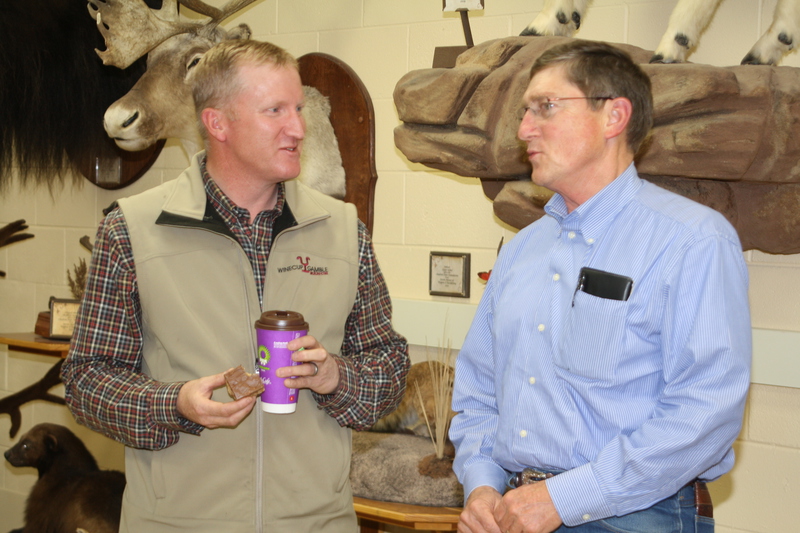Manager of huge Nevada ranch speaks to range students

CHADRON – The manager of one of the West’s largest and most historic ranches discussed his efforts to make it more productive and environmentally sound during a talk to Dr. Ron Bolze’s rangeland management students at Chadron State College Friday night. His audience included at least 30 area ranchers who were also invited to the session.
James Rogers has managed the Winecup Gamble Ranch located in extreme northeast Nevada the past five years. The ranch encompasses a million acres of high desert country spanning from 4,000 to 8,500 feet in elevation.
The smallest of the 23 pastures has 18,000 acres; the largest 96,000 acres, he said. The cowherd numbers about 7,000.
While the ranch has 247,000 deeded acres, Rogers said it is in “partnership with the federal government” because the remaining 750,000 acres are under the jurisdiction of the Bureau of Land Management. Although it is still among the nation’s largest ranches, it was three times that size until the 1940s, according to the ranch’s website.
Once owned by actor Jimmy Stewart, who died in 1997, it is now owned by Paul Fireman, former CEO of Reebok, athletic shoe and apparel giant. Fireman now heads an investment company and lives in Boston.
Rogers grew up on a ranch near Pinedale, Wyoming, and was in the real estate business for 10 years before becoming the Winecup Gamble manager. He was called an “out of the box thinker” by Bolze, who teaches rangeland management at CSC and has visited the ranch three times.
Rogers said his top priority now is to utilize the best land and cattle management principles possible.
But making the people who worked on the ranch more invested and productive five years ago was the top priority when he took over as the manager.
Rogers said both the ranch and its people “were broken.” He said the buildings, including the houses, were run down and employee morale was suffering.
Using the analogy, “Classy gals don’t look for trashy guys,” he said considerable money was spent repairing both the homes and the other buildings, trying to improve both the working and living conditions.
“We gave them more responsibilities and they have achieved more,” he said. “The cream always rises to the top.”
The ranch has 21 full-time employees and also hires seasonal help and contracts the haying. He invited CSC students to apply for internships to work on the ranch.
He also stated that as the general manager, “I try to know a little about a lot on the ranch and let those who know a lot about a little take care of their areas of expertise.”
Because of the size of the ranch, he said he personally switched from riding horses to motorcycles to keep in touch with what’s happening. The two headquarters are 50 miles apart on a gravel road.
Because of some of its rugged terrain, horses still play a major role on the ranch, he added.
Rogers said the ranch welcomes visitors and never shies away from showing them the problem areas in hopes they can suggest solutions.
“We try to mimic nature,” he said. “They used to trap beavers and sell the hides. We don’t do that now. During the drought in 2012-13, the beaver dams were about the only places where our cattle could water. Everything else had gone dry.”
He added that developing watering places has been a priority in an effort to better utilize the grazing land. He said that in the heat of the summer cows will not venture more than a mile and a half from the source of water.
Rogers said a few years ago, the cowherd was divided into three herds, making it easier to manage. During his video presentation, he showed maps of where the herds are run at various times of the year to help prevent overgrazing.
He noted this has been a good year for the ranch. It has received from eight to 10 inches of precipitation and is the first since he’s been there that the ranch hasn’t had fire.
“We keep a lot of records on how we’ve utilized the land and try to make sure we don’t damage it,” the speaker said. “In our country, it can take a long time for it to recover.”
He said the ranch begins calving about April 10, all of it in the open. He said it retains about 1,200 heifers annually and the 100 or so that have not raised a calf are sold. “We don’t give them a second chance,” he observed.
But a couple of hundred 10- to 12-year old cows that continue to raise calves are given special treatment and retained for raising bulls used on the ranch to utilize those genetics, he said.
Because of its growing popularity, grass fat beef is Winecup Gamble’s specialty. Rogers said it takes from 22 to 26 months for those steers to be ready for marketing.
Category: Campus News, Range Management
